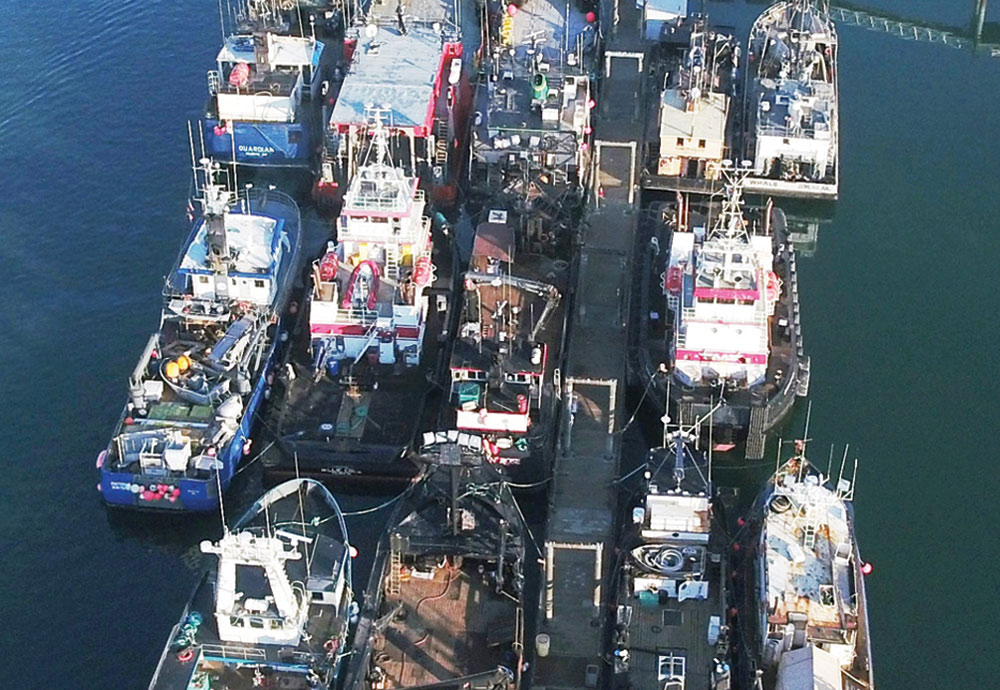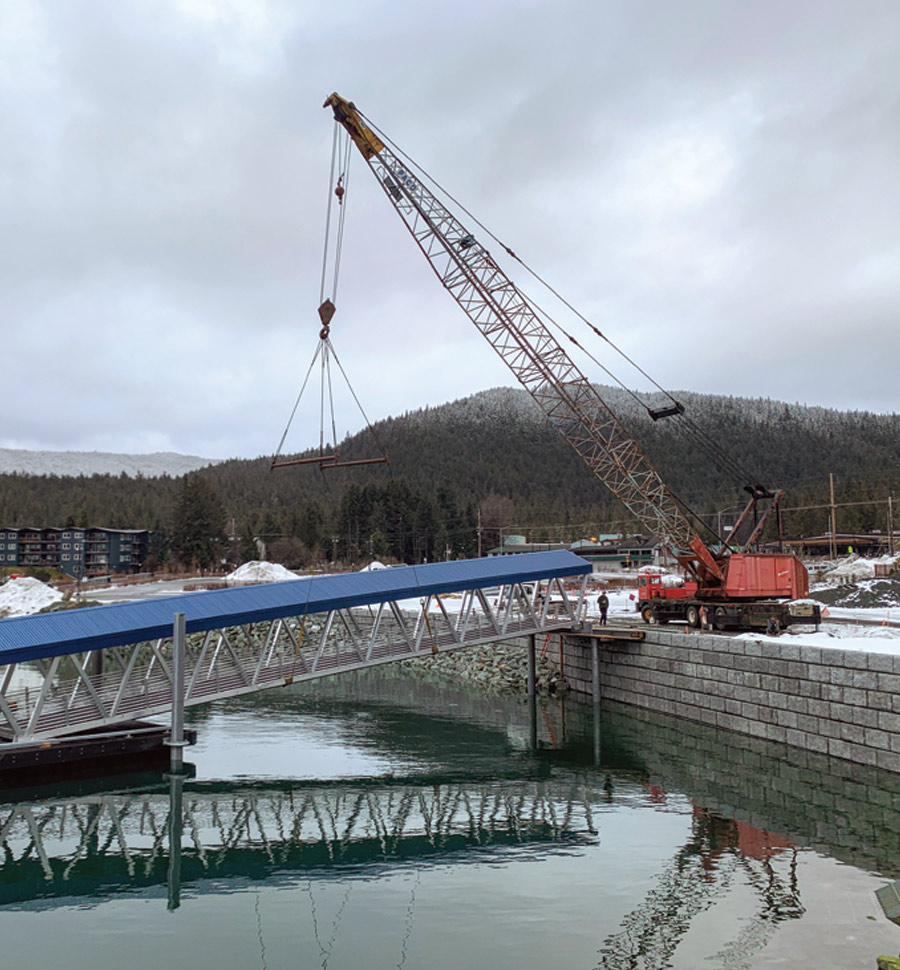hether delivering groceries to Cape Fox or equipment to the North Slope, providing the infrastructure needed to deploy equipment to Alaska’s military bases, or supporting the millions of tourists who arrive via cruise, Alaska’s economy relies on the maritime industry.
And with 90 percent of Alaska’s freight entering the state by marine vessel, ship, or barge, maintaining the state’s maritime infrastructure is essential.
To keep things running efficiently and safely, the ports and harbors that serve the industry undergo a steady stream of renovations, modifications, and expansions to keep pace with evolving user needs and facilities that degrade due to the forces of time and the elements.
“We support large national corporations, we support the commercial fishing industry, we support recreational boating, we support the pedestrian that just wants to walk along the sea walk,” says Port Director Carl Uchytil. “The need is really access to the water.”
In October 2019, City and Borough of Juneau’s Docks and Harbors began the $8.4 million Statter Harbor Improvements Project. Expected to be completed in May 2021, the project will modernize the popular Auke Bay harbor, which has a yearlong waitlist of eighty-five vessels, by adding a “for-hire float” and new gangway to provide more access for recreational boaters, fishing, and whale watching vessels. Pacific Pile & Marine dredged the basin, which allowed Trucano Construction to install roughly 900 feet of float destined for use by charter vessel operations.
“Looking at that project, we see the value of creating something for the local tour companies that are involved in the industry but also building that capacity that adds more float area for the locals to find moorage,” Uchytil says.
Downtown, Trucano Construction also completed a $12.5 million project at the Archipelago Lot, which stretches along the waterfront from Marine Park to Taku Dock. Part of the city’s 2004 long-range Waterfront Development Plan, the project decked over portions of the Archipelago Lot and built a staging area for the small airporter-sized buses that take tourists around town, Uchytil says.
“We know there’s a need to have more room to create a nicer atmosphere along the waterfront, so we’re very pleased with how that turned out,” Uchytil says. Future plans at the Archipelago Lot include adding a covered staging area for tourists and more restrooms.
Zinc anode replacements scheduled for Statter and Harris Harbors this summer will extend the life of the harbors’ pilings by one-third, he adds.
“The biggest, brightest, boldest, most sexy one is the Port of Alaska Modernization Program,” says Jim Jager, director of business continuity and external affairs. “[It’s] basically a dock replacement program that is replacing aging infrastructure.”
Phase I is construction of the Petroleum and Cement Terminal to replace the Petroleum Oil Lubricants Terminal 1, which has served as the Port of Alaska’s primary petroleum terminal and Alaska’s only bulk cement-handling marine terminal since 1965. Deterioration due to age and earthquake damage, combined with technological advancements that changed the way cargo is offloaded, means the current dock has reached the end of both its usable and economic life.
Homer Port and Harbor

Homer Port and Harbor
The Petroleum and Cement Terminal will have the necessary technology to efficiently offload containerized cargo, which means that functionally, the old and new docks will likely be similarly sized, Jager says. But because the upgrades will significantly decrease offload times, the new dock will have an effectively greater capacity.
“With the new dock, we expect that that cement offload time is going to be cut in half, partially because it’s going to be located closer to the cement facility and partially because it’s going to be using the new technology,” Jager says.
Other waterside projects include the continuation of a pile jacketing program that reinforces degraded piles with steel jackets and replacing damaged portions of some fender piles, says Port Modernization Program Director Sharen Walsh. Each project is roughly $1.5 million, although the fender repair project is dependent upon receipt of an US Army Corps of Engineers permit, she adds.
Shoreside, the Port of Alaska will continue draining repairs leftover from the 2018 earthquake and some power upgrades, Jager says. A project to stabilize the Port of Alaska’s north end could begin as early as 2022, pending the outcome of litigation between the Municipality of Anchorage and the US Department of Transportation Maritime Administration, he adds.
“We serve nearly every maritime industry that traverses the Bering Strait because there’s nowhere else to go,” Baker says. “We’re kind of like a one-stop-shop for everybody,” with vessels utilizing the port for crew changes, to resupply, and for emergency medical services.
“We are pushing the breakwater out about 3,500-feet from the end of the existing causeway, so we can get to deeper water and dredge a 40-foot basin to accommodate the larger ships,” Baker says.
Other projects currently in the design and funding phases include completion of an 18-acre pad, roughly $2 million to $3 million; development of a ship waste reception facility, estimated at $5 million to $6 million; and an estimated $14 million to $15 million project to build small vessel moorage floats in the Snake River to address overcrowding in the Small Boat Harbor, Baker says.
This summer, the Port will replace anodes at three aging docks to protect the steel’s integrity and will put out an RFP to replace the port’s concrete launch ramp, a project that was pushed back a year due to COVID-19, according to Baker.
“It wasn’t intended to service heavy vessels, and we’ve got so many vessels trans-shipping out of Nome that we didn’t envision because the cargo and gravel built up so quickly,” Baker says. “So the ramp has taken some abuse and it’s time to replace it.”
Juneau Docks & Harbors

Juneau Docks & Harbors
“We’re in the process of negotiating with a developer to replace that dock, which would be a couple of years project,” he says. “The idea is to have someone remove the dock without interruption to service and build a new dock and a new building on the shore that processes passengers, because we get a lot of cruise ships there.”
The goal is to have the project awarded this spring, and construction completed and ready for the 2024 season, Kubitz says. He anticipates that planning for the project will cost $65 million to $70 million.
ARRC also plans to extend and widen its existing freight dock to accommodate heavy freight and rail and to serve as a backup to the Port of Alaska, Kubitz says. The railroad decided to push the project back until 2022. It will be funded by a Build America grant awarded in 2020.
“With the passenger dock going to start this fall, we kind of have to pace ourselves,” he explains. “Two dock projects are a pretty big deal in the same area.”
“We’re going to do some bridge decking repairs to the causeway and ramps to the floating dock and rebuild the fittings on each side of that,” Talbott says. “This should extend the life of the infrastructure up to twenty-five years. The causeway will go first in the spring and the transfer ramp will go in the fall.”
“We have a very diverse customer user group, ranging from truly recreational all the way to heavy industrial vessels,” says Harbormaster Bryan Hawkins. The port and harbor serves commercial freight vessels, is a homeport for the MV Tustumena, the Coast Guard Cutters Hickory and Naushon, and draws recreational boaters and commercial fishing vessels from far beyond Homer.
Juneau Docks & Harbors

Large national corporations, the commercial fishing industry, recreational users, and pedestrians all need access to the water in Juneau, meaning waterfront projects are a priority for the community.
Juneau Docks & Harbors
“The Port Expansion Project would build another harbor just to the north of the existing basin that would be dedicated to the larger vessels,” Hawkins says. “It would move the large vessel fleet here in our small boat harbor to this new port.”
The project must first undergo a three-year, $3 million preliminary investigation by the US Army Corps of Engineers to justify the need for federal funding, Hawkins explains. But he says the expansion will ultimately improve both Homer’s and the state’s ability to serve the maritime industry.
“Our facility is beyond capacity and we’re turning vessels away,” Hawkins says. “I have customers mooring large vessels in Washington and Oregon because they can’t moor them in Alaska, and it costs them to run back and forth. As a state, we really need to focus on our core industries, and the maritime industry is definitely one of our core industries. We should be focusing on trying to serve that fleet in the future and building the infrastructure that supports and promotes growth in our commercial fleet will grow Alaska’s economy.” ![]()